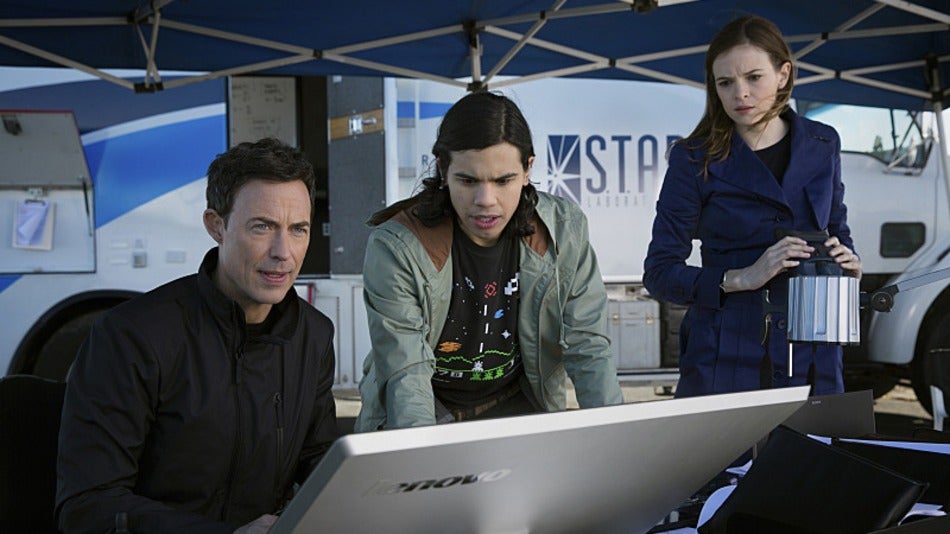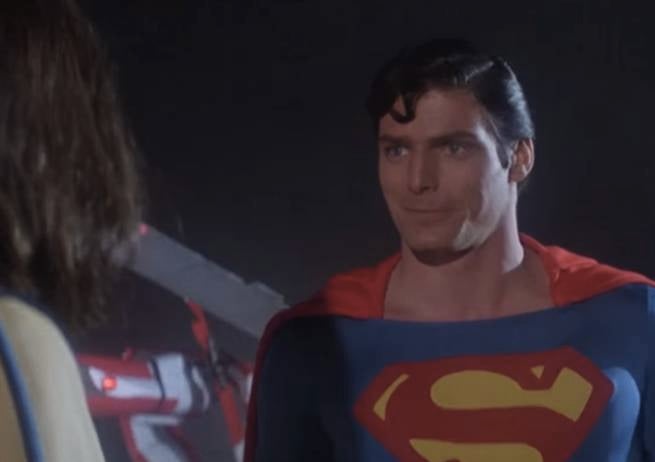
What better way to celebrate that venerated internet tradition of “Throwback Thursday,” while simultaneously wallowing in how much we miss superhero TV now that it’s in its offseason, than by looking back on some past shows?
Videos by ComicBook.com
I’ll be honest, though: the idea of doing recaps, liveblogs, and the like for TV shows that aired years ago isn’t something that’s ever caught on with the ComicBook.com audience. It’s not an inherently flawed idea, and some other websites have had some success with it, but the few times we’ve tried it, the response hasn’t been particularly enthusiastic.
Recently, though, I started watching Lois and Clark: The New Adventures of Superman for the first time ever. I’d seen a couple of episodes over the years, but it was not something that I had made a priority when it was on TV — honestly, I never watched any comic book TV show regularly until Arrow‘s second season — and because I had always heard that it aged poorly, it wasn’t a huge priority in terms of getting caught up.
Until Superman: Lois and Clark hit the stands. The comic book series, by Dan Jurgens, Lee Weeks, and a number of other contributors, debuted about 8 months ago and quickly became my favorite comic on the shelves. Because of the title connection to Lois and Clark, we ran a piece by KryptonSite founder Craig Byrne on the show’s best episodes. Reading it, a lot of the material sounded fun, so it seemed like it was worth seeing if I had missed anything with Lois and Clark.
What I found was a show that is far more steeped in DC lore and in the mid-’90s Superman material that is near and dear to my heart than I could possibly have expected. Until Smallville, I was always under the impression that DC’s live-action superhero properties were a bit like the Batman movies or The Adventures of Superman: maybe a few DC locales would show up, but certainly you wouldn’t have the bonanza of Easter eggs that we’ve come to expect week in and week out from The Flash, Supergirl, and the like. Boy, was I wrong.
So as timing allows during TV’s hiatus, we’ll take a look back to Lois and Clark, not to recap a 20-year-old show as such, but to look a little closer and pick out the Easter eggs, DC Comics and pop culture references, and to see how much fun it can be to put a show like Lois and Clark under the kind of close scrutiny new superhero shows get.
LOIS LANE’S DAILY PLANET

That cold open – The remnants of the show’s original title and concept — Lois Lane’s Daily Planet, a show that would have centered on the newsroom much more than on Superman’s exploits — is evident in the first couple of minutes, when we see Lois undercover, and then see the celebration of her accomplishment.
We see this in the pilot, particularly, where there are basically two endings to the episode: one that revolved around Lois and Clark saving the day and then Superman popping in at the end to do his part, too.
There’s also the Daily Planet logo. There have been plenty of logos for the newspaper over the years — and the one currently being used in the DC Extended Universe has a history in the comics, too — but the one that appeared in Lois & Clark was the logo that was in use in the comics at the time.
METRODOME

The Metropolis Metrodome hasn’t been a significant presence in the comics, that I know of, but referenced in DC Universe Online.
In the comics, H.I.V.E. agents began collecting exobytes around the Metrodome.
You can see the image above.
THE MESSENGER ATTACK

Space Program “The Messenger” Attack/Explosion – In John Byrne’s The Man of Steel, Superman’s first appearance was saving an experimental space plane.
Since so much of Lois & Clark was heavily based on the post-Crisis comics of the late ’80s and early ’90s, certainly the use of the space program here is a nod to that.
LEXTEL

While Lextel has never been a major part of Lex Luthor’s corporate and media empire, it does exist.
And, yes, it popped up on the TV series, its logo appearing a lot in the pilot episode of Lois & Clark.
SPACE STATION PROMETHEUS

The name of the space station in this episode is Prometheus, which has a bit of a history with Superman.
Obviously, Lex had a “Prometheus” speceh in Batman v Superman: Dawn of Justice.
Not only is Prometheus the name of a DC Comics villain…but the mythological story of Prometheus and the notion of man conquering a god was already invoked by Lex Luthor as an anti-Superman metaphor in Superman Returns.
CAT GRANT

Likely now best known to fans as Supergirl’s boss on Supergirl, Cat Grant was introduced right after The Man of Steel reboot happened and brought on as a gossip columnist at the Daily Planet.
While her comic book counterpart lost a child, struggled with alcoholism, and overcame long odds to gain the respect of her peers, making her perhaps more like the Supergirl version than anything else, Cat has generally been depicted as a pretty unlikable and often air-headed person on shows like Lois & Clark and Smallville.
That characterization has carried over to the comics, where she has often been pretty dippy and forgettable in the last decade or so.
CLARK’S TRAVELS

In the post-Crisis continuity — bolstered by the soft reboot in Superman: Rebirth and used in various other media including Man of Steel (the movie) — Clark Kent traveled the world honing his investigative journalism skills as well as righting wrongs and preventing catastrophes before he ever put on the cape as Superman.
There are numerous callbacks to Clark’s time in developing nations and around the world in the pilot.
CARLINI’S

The restaurant used by Perry White in the Lois & Clark pilot is Carlini’s, a staple in the comics around this time.
Carlini’s is named for then-Superman group editor Mike Carlin, who occasionally used “The Great Carlini” in editorials and the like in the ’90s.
ALIVE AND WELL

At the time this show was made, Jonathan and Martha Kent were alive and a vital part of Superman’s supporting cast in the comics.
While the death of Jonathan Kent in particular has been milked for a lot of story potential between the Donner movies and Geoff Johns’s run on Action Comics about ten years ago, seeing the two of them alive and active more or less cements this as a story that took place in the time between 1985 and 2005.
LIKE A FROG

Jonathan’s worries that the government will “dissect you like a frog” if they got their hands on Clark is something that would be echoed throughout various forms of media.
Of course, at one point his paranoia is met with the question from Martha as to whether Clark should just “let that man die,” and here, unlike in Man of Steel, the question guilts Jonathan into silence.
LUCY LANE

Here, we get Lucy Lane.
She didn’t play a particularly big role in the comics of the time, although she would periodically pop up to either be a romantic complication for Jimmy Olsen or to set up family stories with Lois.
Here, she’s bascially just a sister who Lois can talk about boys with. I don’t remember her ever playing a particularly significant role in Lois & Clark past the pilot, either, but we’ll see as I watch through.
LOIS’S DISDAIN FOR SMALLVILLE

Referring to Clark AS “Smallville” and disparaging the small town is nothing new to Lois. Around this time it was less common than it later would be, but I remember distinctly that this kind of attitude carried over in a big way to the soft reboot in 1999/2000, when Jeph Loeb, J.M. DeMatteis, and others would take over the Superman titles.
We saw a bit of it in Smallville, too, obviously, although there it was a bit less arbitrary since Smallville was (as the title implies) a bigger part of the overall story.
CAT & CLARK

Here, we get Cat coming onto Clark plenty, and taking potshots at Lois to boot.
Both of these are things that happened early in her time as a character in the John Byrne/Marv Wolfman/Jerry Ordway period of the Superman titles.
Cat was introduced as a potential love interest for Clark Kent. Part of the idea was that since the The Man of Steel reboot was making Clark more competent and subverting the old trope that he’s kind of a clumsy oaf in his civilian life,
LOIS AND LEX

Lex Luthor’s crush on Lois Lane is one that doesn’t go away quickly in Lois and Clark.
There is, of course, a long history between the two in the comics and other media. This is far from the first time we’ve seen the two flirting or even being intimate. It’s happened everywhere from comics to the animated series, and it was a storyline that would play out throughout the whole first season of Lois & Clark.
LOOK UP

“I must confess that everyone in Metropolis has to look up in order to see me,” Lex admits when pointing out that his building is the tallest in Metropolis.
This is, of course, an important metaphor. Superman is a flying man, who can and does pass over Lex’s tower even without trying to (plus, of course, the “…just look up!” swipe that Superman gets in at the end of this episode). It’s part of Lex’s deep-seated fear of inferiority, which feeds into his hatred for Superman. In many versions of the mythology, it’s this feeling that makes Lex resent the fact that Superman’s abilities are god-given rather than “earned.”
S.T.A.R. Labs

Apparently Jimmy has friends at S.T.A.R. Labs.
In the comics around this time, S.T.A.R. Labs were in heavy use by both the Superman titles and Roger Stern’s Starman (Stern being one of the Superman writers at the time).
Of course, now (especially for casual fans), it’s mostly known as the place where The Flash hangs his hat on The Flash.
LEX’S WOMEN

At around 46 minutes, we see that Lex Luthor isn’t above using his money and sex appeal to manipulate women to his own end.
This was a pretty common thing in the post-Crisis Superman comics, where even as an older man, Lex maintained a powerful physique and had a steady stream of beautiful female assistants.
Probably the best known would eventually be Mercy Graves, his bodyguard and assistant, who recently made her big-screen debut in Batman v Superman.
FORTUNE COOKIES

While Clark may have flown around the world to get Chinese food, it’s not clear where he would have got it in a way that it came with fortune cookies, which it’s my understanding are uncommon-to-non-existent in China.
In spite of being common at Chinese restaurants in the U.S., fortune cookies are said to have originated in California, likely from immigrant groups hanging an inexpensive dessert product on Western stereotypes about “ancient Chinese wisdom.”
Of course, in fairness to the show, Shanghai (where he’s shown to have flown) is a city with plenty of Westernized attractions.
INSPECTOR HENDERSON

Henderson isn’t played by the same actor here as he was later in the series. In fact, his use in the pilot would turn out to be one of six episodes in which he would appear — with the first three each seeing a different actor play William Henderson.
Eventually, he would even shift from being depicted by a person of color (Mel Winkler in the pilot and Brent Jennings in “Neverending Battle” to a white actor who more closely mirrored his appearance in the comics (Richard Belzer of Law & Order fame).
Henderson first appeared on the radio in 1940, and continued as a recurring, supporting character throughout The Adventures of Superman radio and television shows. He didn’t show up in the comics until the 1970s, and tends to be used less there, although he was a fairly significant supporting character periodically from the ’70s through the ’90s, when writers like Louise Simonson, Jerry Ordway, and Dan Jurgens counted The Adventures of Superman among their big influences.
He was promoted to Police Commissioner during that time, so that he didn’t have the same day-to-day presence in the comics, but he had plenty of “screen time” in Superman: The Wedding Special.
Henderson has also served as a supporting character in Black Lightning, Superboy and Supergirl comics.
GOOD NIGHT, ANTOINETTE

Lex Luthor killing the “loose ends” that help him craft his master plans is a common trope for storytelling of the post-Crisis era.
Probably the pinnacle of this is when he killed Sydney Happersen, his personal aide and longest-running partner in crime, following “The Fall of Metropolis” in Action Comics #700, but in order to maintain his facade as a legitimate businessman, Luthor pretty routinely killed his co-conspiritors.
THE “TRYING ON COSTUMES” MONTAGE

A fairly common trope among certain kinds of superhero storytelling, we’ve seen this a few times, memorably in the recent Supergirl pilot.
Even the suits Clark wore might have a few recognizable meanings:
The green one with a yellow circle may be a bit of a nod to the pre-Crisis look of Jor-El, Superman’s Kryptonian father. We also get what is pretty clearly the Captain America costume, except with yellow stripes instead of white around the midsection and no mask.
A BIRD, A PLANE

A ’90s-ified callback to the classic “it’s a bird, it’s a plane” thing gets recited when Superman shows up for the first time at the site of the rocket taking off.
Of course, we don’t get the “…it’s Superman” here, because he hadn’t been named yet. Also, they were playing things somewhat seriously and used it for comic relief when nobody believes the man who says it’s a flying guy in tights and a cape.
EATING THE BOMB

I’m sure this is the kind of thing that has happened plenty of times before, but most of all, it reminds me of when Superman ate the inert Kryptonite during “The Sandman Saga.”
A FRIEND

“I’m…a friend,” Superman tells the little girl who asks him who he is after he makes his first appearance — a callback to 1978’s Superman: The Movie.
Recently in the comics, this scene was also homaged when the pre-Flashpoint Superman showed up to help the New 52 Superman battle a villain, and the pre-Flashpoint Superman identified himself simply as “a friend” when the other Superman asked him who he was.
LOIS NAMES SUPERMAN

How Superman gets his name has been different in various different versions of the origin story, but in the post-Crisis era (and many others), he gets it from Lois Lane, who is the one who coins the name for her Daily Planet story.








